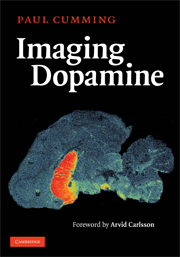Book contents
- Frontmatter
- Contents
- Foreword
- Acknowledgments
- Introduction
- 1 The life history of dopamine
- 2 Enzymology of tyrosine hydroxylase
- 3 The assay of tyrosine hydroxylase
- 4 Enzymology of aromatic amino acid decarboxylase
- 5 PET studies of DOPA utilization
- 6 Conjugation and sulfonation of dopamine and its metabolites
- 7 Dopamine synthesis and metabolism rates
- 8 MAO activity in the brain
- 9 Vesicular storage of dopamine
- 10 Dopamine release: from vesicles to behavior
- 11 The plasma membrane dopamine transporter
- 12 Dopamine receptors
- 13 Imaging dopamine D1 receptors
- 14 Imaging dopamine D2 receptors
- 15 Factors influencing D2 binding in living brain
- 16 The absolute abundance of dopamine receptors in the brain
- 17 Conclusions and perspectives
- References
- Index
- Plate section
5 - PET studies of DOPA utilization
Published online by Cambridge University Press: 04 December 2009
- Frontmatter
- Contents
- Foreword
- Acknowledgments
- Introduction
- 1 The life history of dopamine
- 2 Enzymology of tyrosine hydroxylase
- 3 The assay of tyrosine hydroxylase
- 4 Enzymology of aromatic amino acid decarboxylase
- 5 PET studies of DOPA utilization
- 6 Conjugation and sulfonation of dopamine and its metabolites
- 7 Dopamine synthesis and metabolism rates
- 8 MAO activity in the brain
- 9 Vesicular storage of dopamine
- 10 Dopamine release: from vesicles to behavior
- 11 The plasma membrane dopamine transporter
- 12 Dopamine receptors
- 13 Imaging dopamine D1 receptors
- 14 Imaging dopamine D2 receptors
- 15 Factors influencing D2 binding in living brain
- 16 The absolute abundance of dopamine receptors in the brain
- 17 Conclusions and perspectives
- References
- Index
- Plate section
Summary
General aspects of the quantitation of FDOPA utilization
PET recordings consist only of the total radioactivity concentration in brain volumes as a function of circulation time. How then is one to deduce the rate of decarboxylation of AAADC substrates in living brain, knowing (without the luxury of dissection and HPLC analysis of brain extracts) only the total amount of radioactivity in a volume of brain tissue and the concentration of the tracer in blood? The exogenous AAADC substrate FDOPA has been used in hundreds of PET studies. The quantitation of FDOPA uptake in brain is formally similar to the cases of fluorodeoxyglucose (FDG) and [11C]tyrosine. Thus, FDOPA passes reversibly across the blood–brain barrier by a process of facilitated diffusion. In the brain, FDOPA can be trapped as non-diffusible [18F]fluorodopamine at a rate defined by the local AAADC activity, k3D. In most PET studies, substantial amounts of the inert plasma metabolite O-methyl-FDOPA (OMFD) also enter the brain, creating a diffuse and non-specific background radioactivity on which the specific signal is superimposed. The model for FDOPA kinetics is schematically represented inFigure 5.1, which is essentially a simplification of the more detailed compartmental model, presented in the preceding chapter. The objective of this chapter is to review the various methods that have been brought to bear on the quantification of PET studies with FDOPA and other substrates for AAADC (Hoshi et al. 1993) and to show how these different methods illuminate different aspects of the life history of dopamine in different clinical conditions.
- Type
- Chapter
- Information
- Imaging Dopamine , pp. 54 - 79Publisher: Cambridge University PressPrint publication year: 2009
- 1
- Cited by



